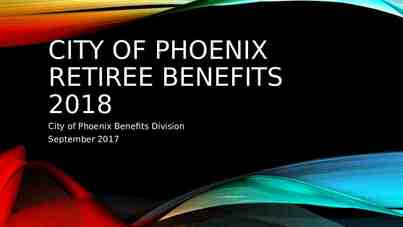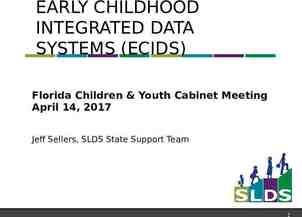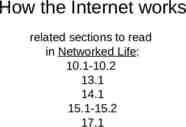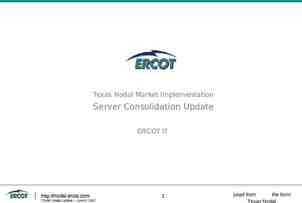Universal Prekindergarten (UPK) Planning Template Webinar
48 Slides1.94 MB

Universal Prekindergarten (UPK) Planning Template Webinar Early Education Division (EED) January 13, 2022 CALIFORNIA DEPARTMENT OF EDUCATION Tony Thurmond, State Superintendent of Public Instruction

Welcome and Introductions 2

Who is in the ‘room’ with us today? California County Superintendents Educational Services Association (CCSESA) regions: Northern CA: Regions 1 and 2 (orange) Greater Sacramento: Regions 3 and 6 (blue) Bay Area/Coastal: Regions 4 and 5 (purple) Central Valley: Region 7 (green) Inland Empire: Region 10 (yellow) Southern CA: Regions 8, 9 and 11 (red) CCSESA: http://CCSESA.org/regions/ 3

Introduction to Universal Prekindergarten Photo Credit: UPS Preschool; Camarillo, CA 4

What is UPK? UPK will bring together programs across early learning and K-12, relying heavily on Universal Transitional Kindergarten (UTK) and California State Preschool Program (CSPP), as well as Head Start, community-based organizations (CBOs), and private preschool to ensure every four-year old child – regardless of background, race, zip code, immigration status, or income level – has access to a quality learning experience the year before kindergarten. 5

How Do Transitional Kindergarten (TK) , UPK and P-3 (Preschool through grade 3) Alignment Work Together? P-3 Connects UPK with Kindergarten, 1st, 2nd, and 3rd grade Aligning developmentally informed best practices, UPK– 3rd grade. UPK is a mixed-delivery system of UTK, CSPP, Head Start, private providers, and more Provides every four-year old access to high quality learning the year before kindergarten TK is an integral program in the mixed delivery system for achieving UPK The only program that must serve any four-year old child that wants to enroll by 2025-26. 6

UPK Implementation Timeline (1) 2021–22 Plan for UPK. Funding available for planning and workforce development. Any child who turns five Sep. 2 – Dec. 2 eligible for TK. Children born Dec. 3 – Jun. 30 may be served at local educational agency (LEA) discretion in Early Admittance TK (ETK). 130 million available for LEAs to expand CSPP. Rates in CSPP increased. Plans for full-day UPK due to governing board by Jun. 30, 2022 for consideration. 7

UPK Implementation Timeline (2) 2022–25 Plans for full-day UPK due to governing board by Jun. 30, 2022 for consideration. LEAs required to expand TK to serve two months more of birthdays each year. TK: Average class size: 24. Adult/child ratio: 1:12 (2022–23) and 1:10 starting in 2023. LEAs can phase-in UTK faster if they choose by serving children in ETK. 2025–26 LEAs required to make TK available to all children who will have their fourth birthday by Sep. 1 of the school year. 8

Governor’s Budget Photo Credit: Kidango Decoto Center; Union City, CA 9

Governor's Budget: UTK UTK 640 million to expand eligibility for TK, for all children turning fiveyears-old September 2 and February 2, beginning 2022–23. 383 million to add an educator to every TK class Expanded Learning (Includes Support for TK) Increases: 3.4 billion for expanded learning rates and the Expanded Learning Opportunities Program (ELO-P) 10

Governor's Budget: CSPP 309 million to increase CSPP adjustment factors to better support students with disabilities and dual language learners. All students participating in CSPP will maintain continuous eligibility for 24 months (increased from 12 months). After all eligible three- and four-year-old children are served, CSPP can serve eligible two-year-old children as last priority. 11

Governor's Budget: Inclusion Children with an individualized education program (IEP) will be categorically eligible for CSPP. New requirement for CSPP to serve at least 10 percent of children with IEP (similar to Head Start). 500 million to support the Inclusive Early Education Expansion Program (IEEEP) 2 million to incorporate early identification for learning disabilities into the state’s preschool assessment tools 12

Governor's Budget: Professional Development 60 million to provide training for educators on effective use of assessment tools 54.4 million to build upon the multi-year investments included in the 2021 Budget Act to support efforts to enhance schools’ ability to hire qualified teachers and substitutes 13

Introduction to UPK Planning and Resources Photo Credit: Poplar Avenue School; Oroville, CA 14

UPK Plan Requirements As specified in Education Code (EC) 8281.5, LEAs must: ‒ Develop a plan for consideration by the governing board or body at a public meeting on or before June 30, 2022, for how all children in the attendance area of the local educational agency will have access to fullday learning programs the year before kindergarten that meet the needs of parents, including through partnerships with: o the local educational agency’s expanded learning offerings, o the After School Education and Safety Program, o the California state preschool program, o Head Start programs, o and other community-based early learning and care programs. 15

Funding to Support UPK Planning and Implementation 200 million available to school districts, county offices of education, and charter schools for planning and implementation ‒ 176 million in grants to LEAs with kindergarten enrollment in specific years to plan for UPK ‒ 24 million in grants to County Offices of Education for countywide planning and capacity building Individual allocations can be found on the CDE Funding Results Page Allowable uses of funds include: planning costs, hiring and recruitment costs, staff training and professional development, classroom materials, and supplies 16

UPK Template and Guidance Template: https://www.cde.ca.gov/ci/gs/em/documents/finalupktemp.docx Purpose of Template: ‒ Offer planning questions to support development of comprehensive plans for UPK (not required) ‒ Outline the data that will be required for submission to the California Department of Education (CDE) to meet the requirements of EC 8281.5 through a survey after June 30, 2022 ‒ Provide additional deep planning questions for LEAs want to go deeper CDE will be issuing additional guidance for LEAs to implement UPK. Topics for this guidance are listed in the template 17

UPK Template Elements Self-Certifications Projected Enrollment and Needs Assessment Planning and Implementation Focus Areas ‒ Focus Area A: Vision and Coherence ‒ Focus Area B: Community Engagement and Partnerships ‒ Focus Area C: Workforce Recruitment and Professional Learning ‒ Focus Area D: Curriculum and Instruction ‒ Focus Area E: District Facilities, Services, and Operations Appendix I: Definitions Appendix II: Additional Optional Deeper Planning Questions for Each Focus Area 18

Joint Plan LEAs are permitted to partner in creating a joint UPK plan and may submit the same plan for multiple LEAs LEAs may partner with their county office of education (COEs) to create a single, countywide plan Small and rural LEAs are strongly encouraged to create a joint UPK plan including non-district learning programs Plans should be developed in conjunction with CSPP, Head Start, other preschool programs, and early learning and care providers 19

Projected Enrollment and Needs Assessment Photo Credit: Ford and Shannon Transitional Kindergarten; Richmond, CA 20

TK Eligibility and Ratios by School Year Type of Requirement Eligibility 2021–22 2022–23 2023–24 Turn five between September 2 and December 2; at LEA discretion, turn five between December 3 and the end of the school year Turn five between September 2 and February 2; at LEA discretion, turn five between February 3 and the end of the school year Turn five between September 2 and April 2; at LEA discretion, turn five between April 3 and the end of the school year Ratios Not specified 1:12 Class Size 24 24 1:10 (Subject to future legislative appropriation) 24 21

TK Eligibility and Ratios by School Year (2) Type of Requirement 2024–25 2025–26 Eligibility Turn five between September 2 and June 2; at district discretion, turn five between June 3 and the end of the school year 1:10 (Subject to future legislative appropriation) 24 Turn four by September 1 Ratios Class Size 1:10 (Subject to future legislative appropriation) 24 22

Data To develop enrollment projections, LEAs could use the following: 1. TK and kindergarten census day and cumulative enrollment counts from 2013–2019 as reported to the CDE. 2. Count of births in each ZIP Code in California as reported by the California Department of Health and Human Services; estimated counts of births in each LEA from 2013–2019; and estimated count of births in each LEA: 3, 4, 5, and 6 years prior to 2013–2026. 3. Estimated population of 3-, 4-, 5-, and 6-year-old children for each county from 2013–2026 produced by the California Department of Finance. 23

Factors That May Increase Projections Local changes that may lead an LEA to increase its enrollment estimates: Early Learning and Care providers in the community that serve TK eligible children have closed or reduced the number of slots they offer New housing developments or large-scale employers moving into the LEAs attendance area or in the instance of employers, general proximity Migration of children and families into the district is increasing or migration of children out of the district is decreasing Birth rates in the district area are increasing The LEA plans to switch from offering part-day to full-day TK 24

Factors That May Decrease Projections Local changes that may lead an LEA to decrease its enrollment estimates: Early Learning and Care providers in the community that serve TK-eligible children have opened or increased the number of slots they offer For future year projections, the LEA assumes fewer parents will choose to enroll younger children in TK Closure of large-scale employers in the LEAs general proximity Migration of children and families into the district is decreasing or migration of children out of the district is increasing Birth rates in the district area are decreasing The LEA plans to switch from offering full-day to part-day TK 25

How comfortable/confident is your LEA projecting TK Enrollment? Photo Credit: Patricia Angulo's Family Child Care; Ventura, CA 26

Focus Area A: Vision and Coherence Photo Credit: Debra Manrique Family Child Care; Oxnard, CA 27

Focus Area A: Vision and Coherence Required Questions for Reporting to the CDE: 1. What model(s) of service delivery does the LEA plan to implement for UPK for all four-year-old children, including classes fully inclusive of children with disabilities, to provide access to the least restrictive environment for learning? 2. Does the LEA plant to implement full-day TK, part-day, or both? 3. Describe how the model(s) of service delivery selected in the preceding two questions will be implemented across the LEA’s sites and why. 4. Does the LEA plan to begin operating a CSPP or expand its current CSPP contract? 5. What age of children does the LEA plan to serve through a CSPP contract? 6. Does the LEA plans to serve students in ETK? 28

How familiar are you with early learning and care programs? Debra Manrique Family Child Care; Oxnard, CA 29

Comparing Service Deliveries (1) TK and ETK Age General Income (years) Requirements 4 Age eligible, not based on income Ratios (adult: child) 1:12 in 2022-23 or 1:10 in 2023-24 with funding Maximum 33 students 24 average class size across the school site CSPP 3-5 85% or less of state median income 1:8 1 teacher 24 students Head Start Income below poverty line 1:10 3s only: Maximum 17 students, 15 for doublesession 4-5s: Maximum 20 students, 17 for doublesession 3-4 30

Comparing Service Deliveries (2) TK and ETK CSPP Head Start Teacher Requirements Multiple-Subject Credential (and 24 units of child development or early childhood education [ECE] by August 1, 2023) Child Development Associate Teacher Permit Teacher: Associates' in ECE Instructional Aide: at least 12 units of ECE Other Notes If teacher first assigned after July 1, 2015, then they need 24 units of ECE by August 2023 Intent to align with Preschool Learning Foundations (PLFs) Required use of Early Childhood Environmental Rating Scale (ECERS), Desired Results Developmental Profile (DRDP) assessment, and curriculum aligned to PLFs Comprehensive services in Performance Standards 31

How CSPP Can Support UPK Efforts CSPP can provide additional resources for LEAs to serve three-year-old children so that children receive two years of high-quality, educational programs to children before kindergarten. CSPP can provide extended learning and care to TK and kindergarten students to support full-day programming for children If districts want to expand UPK faster than the state timeline, CSPP can support the costs of children before their fifth birthday when LEAs can start generating average daily attendance (ADA). A CSPP Request for Applications (RFA) will be released in the near future through the EED email distribution list. ‒ 130 million in CSPP expansion funding is available to LEAs to provide both part-day/year and full-day/year CSPP. ‒ LEAs directly operate these services, subcontract with CBOs, or provide through a family child care home education network (FCCHEN). 32

Leveraging CSPP Funds to Support TK Funding sources can be leveraged to support educational costs to ensure consistency, eliminate duplication of services, and allow for maximum flexibility of funds. Scenario 1: Children funded by one program in one portion of the day For example, TK in the morning and CSPP in the afternoon Scenario 2: Children in same classroom, some funded by one program and other children funded by the other, during the same hours For example, half students funded by CSPP, half students funded by TK 33

Notes Regarding Full-Day UPK UPK Plans: LEAs are required to submit to governing board requiring LEAs to plan for "full-day" learning programs that "meet the needs of parents" If LEAs have the Expanded Learning Opportunities Program funds, full-day means at least 9 hours. This can be accomplished through partnerships with CSPP, Head Start, expanded learning programs, and other early learning and care programs. It is allowable for LEAs to operate kindergarten programs that have a different length of day than their TK programs (EC 37202) 34

Focus Area B: Community Engagement and Partnerships Photo Credit: Kidango Decoto Center; Union City, CA 35

Focus Area B: Community Engagement and Partnerships (2) Required Questions: Identify how LEA obtained public input on the UPK Plan. Which programs does the LEA plan to combine with the TK instructional day to offer nine hours per day of programming (instructional day plus programming) for children whose families opt in for extended learning and care. 36

Do you know who your partners will be in implementing UPK? Lighthouse for Children CDC; Fresno, CA 37

Focus Area C: Workforce Recruitment and Professional Learning Photo Credit: Ford and Shannon Transitional Kindergarten; Richmond, CA 38

Focus Area C: Workforce Recruitment and Professional Learning (1) Required Questions: 1. What strategies does the LEA intend to use to support diverse and effective prospective TK teachers, including multilingual educators, to earn a Multiple Subject Teaching Credential? 2. What strategies does the LEA intend to employ to support diverse and effective prospective TK teachers, including multilingual educators, to meet the requirements under EC Section 48000(g)(4)? 3. What strategies does the LEA intend to employ to support diverse and effective prospective CSPP teachers, including multilingual educators, to obtain a Child Development Teacher Permit? 39

Focus Area C: Workforce Recruitment and Professional Learning (2) Required Questions: 4. What child observational assessments does the LEA intend to offer professional learning to TK, CSPP, and other early education teachers during the 2022–23 school year? 5. What topics does the LEA intend to offer professional learning regarding early childhood education to site leaders and principals? 40

Funding Opportunities to support UPK and P-3 Workforce Development The Early Educator Development Grant - 100M; LEA Educator Effectiveness Block Grant - 1.5B; LEA National Board for Professional Teaching Standards Certification Incentive Program – 250M; LEA (school districts) Teacher Residency Grant Program – 350M; LEA California Classified School Employee Teacher Credentialing Program - 125M; LEA Golden State Teacher Grant Program – 500M; Individual students 41

The Early Education Teacher Development Grant Program Funds are available to eligible LEAs, which include charter schools, school districts, and county offices of education. Goals are: 1. To increase the numbers of highly-qualified teachers available to serve in CSPP and TK. 2. Provide and elevate CSPP, TK, and K teachers training in specific competencies. ‒ January 19, 2022 5 pm: letter of intent (LOI) due to: [email protected] ‒ February 2022: Application released; technical assistance (TA) webinar to follow 42

Focus Area D and E: Curriculum, Instruction, and Assessment District Facilities, Services, and Operations Photo Credit: Tulare City School District, Garden School (Preschool); Tulare, CA 43

Focus Area D: Curriculum, Instruction, and Assessment Required Questions: 1. Does the LEA plan to provide any language model(s) for TK students? 2. If the LEA administers CSPP, does it plan to provide any language model(s) for CSPP students? 3. Identify methods the LEA plans to use to support the development of socialemotional learning and executive function skills through specific instruction in these areas and by embedding and reinforcing this instruction in all curriculum areas. 4. What instructional practices does the LEA plan to implement to support children with disabilities in UPK programming? 5. What assessments does the LEA plan to use in TK or kindergarten? 44

Focus Area E: District Facilities, Services, and Operations Required Questions: 1. To support an overall increase in UPK access, what efforts does the LEA plan to make to prevent the displacement of any early education programs on LEA campuses, including both LEA-administered and non-LEA-administered programs? 2. Does the LEA have adequate classroom space to meet the Projected Enrollment of TK students listed in the Projected Enrollment and Needs Assessment section, for the respective implementation year? 3. Does the space meet the kindergarten standards described in California Code of Regulations, Title 5, Section14030(h)(2)? 45

Focus Area E: District Facilities, Services, and Operations (2) Required Responses: 4. Does the space contain necessary adaptive equipment, assistive technology, or other accommodations to ensure children with disabilities have access to education in the least restrictive environment? 5. Does the LEA’s Facilities Master Plan adequately address the need for UPK programming? 6. Where does the LEA intend to make updates to facilities? 7. What transportation will the LEA offer to children enrolled in TK? 8. Will the LEA offer transportation to transport TK children to extended learning and care opportunities that are at other sites than the one the child is enrolled at for TK? 46

Investments to Support UPK: Focus Area D and Focus Area E California Preschool, Transitional Kindergarten, and Full-Day Kindergarten Facilities Grant Program: 490M for one-time grants to construct new or retrofit existing school facilities. ‒ Funds also can be used to modernize classrooms to expand a CSPP or TK program CA Preschool Learning Foundations Alignment: 10M to update the CA Preschool Learning Foundations to incorporate recent research in the field, and to develop curriculum, assessment, and educator resources to address preschool to 2nd grade. 47

Closing and Next Steps Inbox for questions and comments: [email protected] We will post this webinar to the California Department of Education Elementary web page: https://www.cde.ca.gov/ci/gs/em/ We look forward to providing the Guidance document for the UPK Planning and Implementation Grant! Thank you! 48






